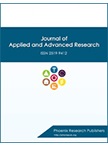Intravaginal Administration Of Misoprostol Alone Versus Misoprostol And Isosorbidemononitrate For Cervical Ripening And Labour Induction
DOI:
https://doi.org/10.21839/jaar.2017.v2i1.52Keywords:
Misoprostol, Labour Induction, Labour Augmentation, Isosorbide mononitrate, Cervical RipeningAbstract
ABSTRACT
OBJECTIVES: To compare the efficacy and safety of intravaginal administration of misoprostol alone versus misoprostol and isosorbide mononitrate for cervical ripening and labour induction.
MATERIAL AND METHODS: One hundred women with term gestation, Bishop score <4 with various indications for labour induction were randomly divided into two groups. In Group I, 50 µg of misoprostol tablet was placed intravaginally, 4 hourly maximum upto 4 doses. In Group II,50 µg of misoprostol tablet with 40mg of isosorbide mononitrate was placed intravaginally in posterior fornix upto 4 doses.
RESULTS: Two groups were similar in their clinical characteristics. The induction to delivery interval was 20.8±2.9 hours vs 14.2±2.7 hours in two groups respectively. Misoprostol and isosorbide mononitrate was associated with a shorter induction to delivery interval, decreased oxytocin requirement higher rate of vaginal delivery i.e 62.8% Vs 53.9% . Uterine hyperstimulation was more common with misoprostol. Neonatal outcome was similar in both the groups.
CONCLUSION: The present study suggests that both intravaginal misoprostol and combination of isosorbide mononitrate and misoprostol are safe and effective modes of labour induction. Isosorbide mononitrate and misoprostol is more effective than misoprostol alone in terms of shorter induction to active phase interval and induction to delivery interval.





 .
.